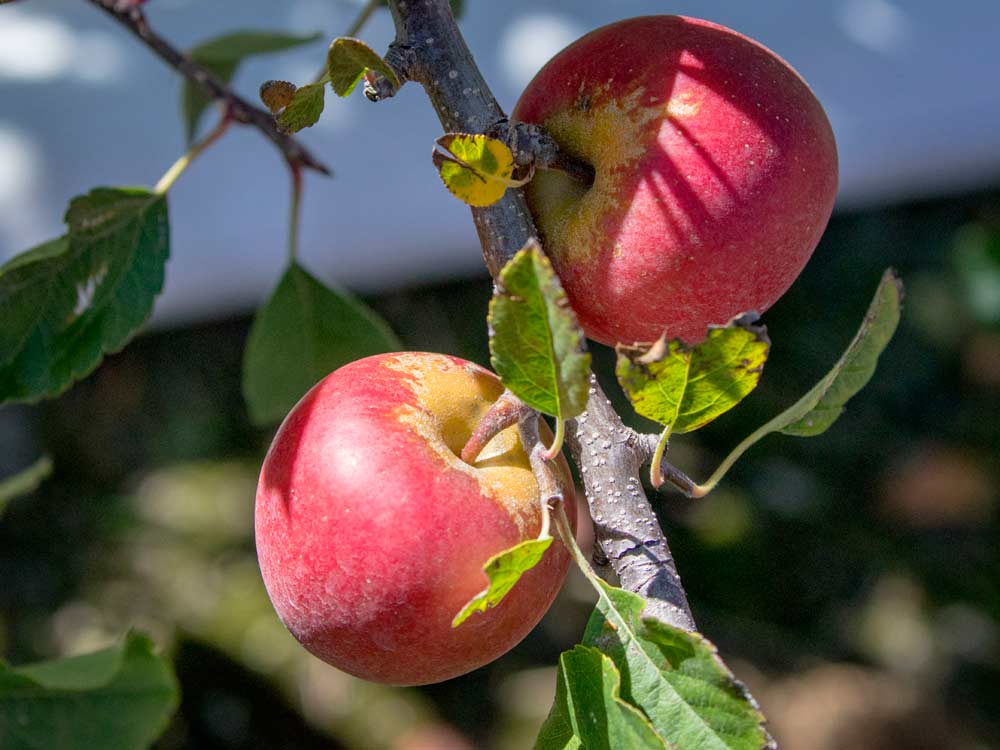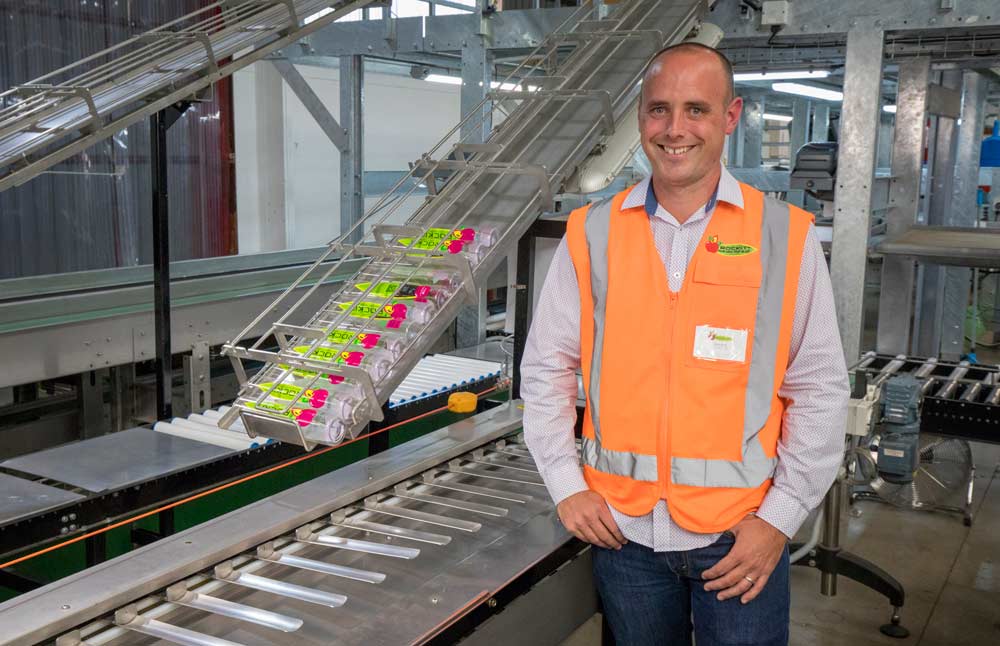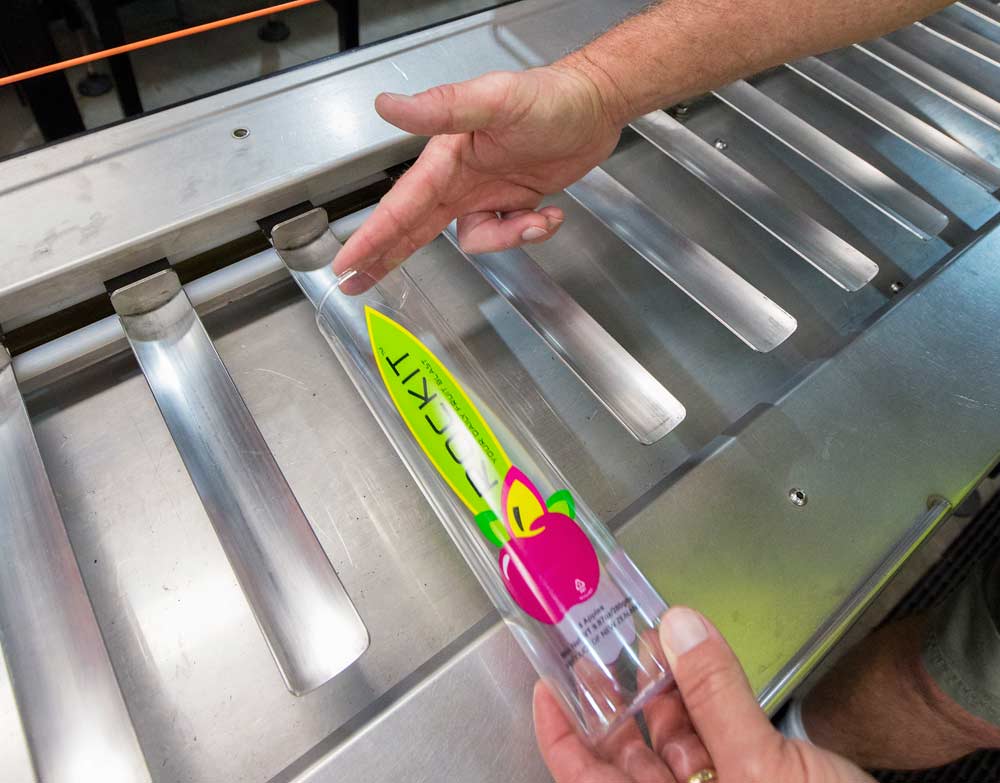
Rockit apples near harvest in the Hawke’s Bay area of New Zealand. The apple has a natural russeting near the stem. (TJ Mullinax/Good Fruit Grower)
In a country known for its new varieties, a small apple is garnering attention beyond New Zealand, and its producers have big ambitions for it in the snack market.
The Rockit apple, a miniature apple from the parentage of Gala and Splendor developed by Plant and Food Research New Zealand, is only about a third the size of a conventional piece of fruit, but packs a sweet punch: Brix of up to 20, but with good pressure and high dry matter due to its compact nature.
The company largely sells them in tubes of three or five pieces — Borton Fruit in Washington state also started packing 3-pound packs — and expects to pack 7 to 7.5 million tubes this year in New Zealand.

Chris Hurrey
Production has grown 40 percent each year, with more on the way. The company itself plans to plant another 80 hectares each of the next three years (1 hectare is a little less than 2.5 acres), and production could reach 60 million tubes in the coming years. A new packing house is likely planned for after next season.
“We have big ambitions, and a lot going on over the next few years,” Chris Hurrey, operations manager for Rockit Global Limited, told attendees of the International Fruit Tree Association tour in February.
So far, the results look good. Selling as a premium fruit in Asian markets, growers are seeing a return of 85 cents per fruit, which fetches as much as $2 per piece at retail.
Key to the effort: Those involved have grown most conventional varieties in the past and recognize that they don’t compete against other apple growers. “We compete against the snack market, and that excites me,” Hurrey said. “We’re doing something different and giving people another alternative to snacks. That’s what Rockit is.”
In the orchard
Formed as Rockit Fruit Co. in 2012, the company underwent a name change to Rockit Global Limited last year when the main founder sold out.
The company has 19 producing orchards, about 160 hectares managed by Rockit Management Services, with five in development and another five in initial stages of development.
However, plans are afoot to plant 80 hectares over each of the next three years, with private growers running another 50 hectares in New Zealand alone.
Hurrey, joined by sector manager Ben James and postharvest manager Andrew Mason, showed IFTA attendees a third-leaf block carrying about 25 tons per hectare and 150 to 250 fruit per tree.

The Rockit apple, its consumer packaging and branding as shown during the 2018 International Fruit Tree Association New Zealand Study Tour and Conference on February 23, 2018. (TJ Mullinax/Good Fruit Grower)
Just over a third the size of a conventional piece of fruit, Rockit’s average fruit weight is 88 grams, and a bin holds 2.5 times the amount of fruit as a bin of conventional fruit.
So is it hard to find pickers, given that it takes 54 buckets to fill a bin?
Not according to Hurrey, as the pay is higher for the smaller fruit. “It can be a bit daunting when you put that first bucket in the bin,” he said with a laugh. “It doesn’t go anywhere.” But he said a lot of workers would rather pick 2.5 bins of Rockit a day, at $80 a bin, rather than go down the road and pick five or six bins at $35.
Picking is by size first and color, and bins are field graded. “I’ve grown a lot of varieties and been in this industry a long time, and I’ve never grown a variety with such high standards — and we have to, because it’s such a premium piece of fruit,” he said.
The variety doesn’t come without a few challenges.
The fruit has a small stem, but the high cropping means a lot of doubles and potential for damage from stem puncturing and bruising at harvest, making it harder to pick. The small fruit also entices workers to want to pick more than one in each hand, so the company has imposed a one fruit per hand rule, regardless of the fruit size.
Rockit naturally develops russeting around the stem, but high heat this year, along with some storms, resulted in additional russeting on the sides of the fruit.
“We accept more than we would in a normal, conventional piece of fruit here,” Hurrey said. They’re trying three sprays of gibberellin A4+7 as a trial through late bloom and early petal fall, but he said he’s not sure if it’s helping to prevent the problem. High heat this season also presented sunburn problems.
Grannys serve as the pollinizers, though in big blocks that are standing alone, more pollinizers are needed; usually a crabapple variety is added to flower early. Flower thinners also are employed in places, namely a new product sold under the brand name Meteor.
“We like to play it safe with the fruit,” he said. “We have to get the tonnage right because the fruit is so small.”
Target yields are about 66 metric tons per hectare; one block has produced 73 tons, while a fifth-leaf block is producing 55 tons. “But at the price we’re getting for Rockit, 55 tons is fantastic money.”

Rockit Global Limited’s Andrew Mason stands next to the custom apple packaging area where the plastic containers are slipped over a stainless steel conveyor tray filled with apples during the 2018 International Fruit Tree Association New Zealand Study Tour and Conference. (TJ Mullinax/Good Fruit Grower)
Packing and marketing
Most Rockit apples in New Zealand are grown in Hawke’s Bay, near Napier, with one grower in Bay of Plenty. All are packed at a Hawke’s Bay packing house that is already nearing capacity in just its fourth year.
Last year, the company packed just shy of 7,000, 400-kilogram bins and expects to top 9,000 bins this year.
“It doesn’t sound like very much, but when there are 5,000-plus apples in a bin, and you’re putting every single one into a tube by hand, it’s quite labor intensive,” Mason said during a tour of the packing house, which was a week out from starting operations.
Seventy employees on one eight-hour shift can pack 55 to 60 bins, or about 60,000 tubes. Staffers worked a daily nine-hour shift last year. This year, to cope with the extra volume, the packing house will be running 15-hour days, with nine-hour and six-hour shifts.
The packing house features a three-lane Compaq sorter and sizer — cameras help to sort the fruit by diameter — with blemish sorting technology. Fruit is packed into and sold in plastic tubes, ranging from three, four and five pieces per tube.
Five tube sizes range from 53 millimeters (just over a couple of inches) to 72 millimeters. Only one color grade, premium, gets packed.

An example of how the Rockit consumer packaging fits over the stainless steel packing line at the Rockit facility in Hawke’s Bay, New Zealand. (TJ Mullinax/Good Fruit Grower)
All of the fruit is harvested in five or six weeks, which can pose some unique challenges, but is packed over six months.
“There’s not too many apple growers out there who do 100 percent of their harvest over five weeks. Most are a bit smarter and have multiple varieties,” said Mark Pay, business development manager.
In addition, unlike most apples, more than 90 percent of the product goes to an agreed-upon sales and marketing program with retailers. Prices are held for the entire season, just as any other snack product would be, to ensure they move volume, Pay said.
“Where there might have been fluctuations in price, we’d rather give 10 cents, 20 cents, 30 cents to promotion,” he said. “It’s a really different way of thinking about it.”
China, Singapore and Vietnam are among the larger markets. Disney also is buying the fruit for sale at its amusement parks.
The prevalence of consumer snacking and an increase in health consciousness are the product’s big drivers, as the company tries to provide a healthy, unprocessed option to consumers, Pay said.
“We’re moving apples away from just being a commodity, where you’re just fighting on price in the supermarket, and taking it to places where apples aren’t generally sold — gas stations, theme parks, cruise liners, airports, stadiums, vending machines,” he said. “We’re not smart enough to compete with every other apple out there. So we’ll just do something else. It makes life a lot easier.” •
—by Shannon Dininny / photos by TJ Mullinax






Leave A Comment